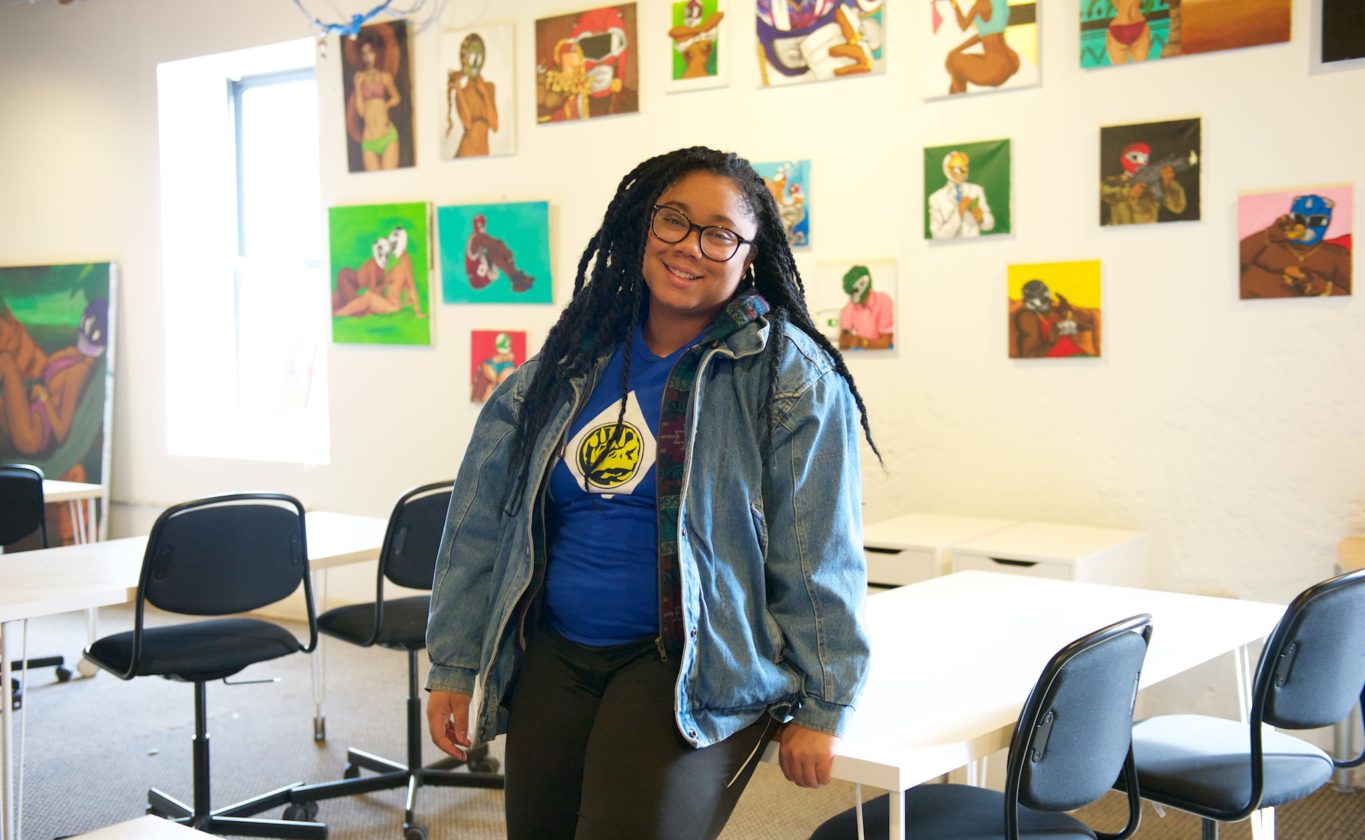The Finesse Center started because I didn’t really know what else to do. After my brother passed, one of my friends from Webster University was like, “Hey, I have someone that wants to donate money. Where should they donate?” I was like, “I don’t know. To the family?” And they said, “You know what? We’re going to start an art center.” So, I started talking to other friends about starting an art center to have somewhere to hang his artwork. A day or two after he passed, we started a GoFundMe and developed the Finesse Center idea.
Those who use the space now are artists, mostly his friends who would work out of his loft down the street. The idea came from taking the community he built in his home and bringing it into a space so people don’t lose that work environment they had. I’d go to his house and he’d be having a party while some people would be doing graphic design and some would be painting. Then some would be dancing to music, talking, or cooking.
“How do you describe your brother’s artwork?”
I saw my brother paint some of these. I would be like, ‘You’re nasty,’ because they’re so explicit. He didn’t really have a reason. He liked Power Rangers since we were kids. He has this picture with my cousin when he was six years old and they dressed up as Power Rangers for Halloween. So, he would paint urban Power Rangers. Most of them are actual people like Future, the rapper; or Michael Jordan; or 2 Chainz. Some of them are his friends he just put Power Ranger helmets on.
He used to win art shows in elementary school. I guess his inspiration was the world around him. I was fascinated with how he could just draw something from memory. He wouldn’t be looking at a picture or anything, but he’d just start painting. He did graphic design in high school, and he designed all of his friends’ mixtape covers. They would come to our house and have photoshoots. He didn’t start painting until after our dad passed. That was therapeutic for him.

Kayla Thompson, photos by Lindy Drew
What’s heartbreaking is that when my brother passed away, it happened close to my home. I was up playing an Xbox game with my friend. I remember looking up like, “Were those gunshots?” My friend asked, “Is that what those were?” Then we just kept playing the game. The next day I heard he died around the same time we heard the gunshots.
He was killed in an attempted robbery in the Central West End. It was shocking because in 2010 my dad died the same way, in an attempted robbery. He was shot and killed June 5th. My brother was killed on June 9th. We had just celebrated my dad’s anniversary. I was over at my brother’s house, and we were talking about it. Talking about what our dad would want us doing now. Then, four days later, the same thing happened down the street. My dad was killed down the street from our house from where we used to live in our childhood home. It just happened to happen where I was again. To have two men in your family pass away in similar ways in the same city? Death doesn’t happen like this. It can’t happen like this. But it did. We didn’t really believe it until we went to the hospital. I was the first one to arrive. I had to identify his body. No one in my family knew.
I had to tell everyone. But I couldn’t tell my mom. When I called her I said, “Something happened to Tyrell. You need to get to the hospital.” When she got there, she was like, “What’s going on?” “Just go in there. I’ll park your car.” I couldn’t break the news to her. I left the task up to my best friends that were there with me. They told her what happened. I walked into her being hysterical and apologized, “I’m sorry,” sorry I couldn’t tell her.
A couple days after my brother passed, I started blogging about it because I didn’t really know what else to do. I wrote a three-part series called Making Sense of Losing My Brother. The first one was a blog piece about losing my dad, and the first paragraph about my brother was almost the same as the first paragraph about losing my dad. “My dad was shot and killed when I was 19 years old just down the street from my house.” Then, “My brother was shot and killed down the street from my house.” It hurt.
My brother didn’t have anything. The most they could’ve taken from him was his phone. He was with a female friend and they were going to a reggae night at Club Viva to go dancing. Someone pulled up on them, pulled a gun out, tried to rob them, and my brother started fighting them. She was able to get away and live. With my dad, he was going out with his friend, he was in his car, and someone 17 or 18 years old tried to rob them. I don’t know much because they didn’t really talk to us about it. And we didn’t hear that much news about my brother beside me going to the news to talk about what we’re doing as a result of his death. They still don’t know who killed him.
After my dad died, my family said, “We want you to be closer to home. We think y’all should be home at least for a while.” So we both came home, got an apartment together, and went to Webster University. He was at school at the Art Institute of Santa Monica, California. I was at Hampton University in Virginia. He never finished school at Webster because he was a terrible student. At LockerDome, he had celebrated his one-year anniversary as a graphic designer, doing exactly what he’d been doing since high school. To him, the job meant he made it because he spent most of his life being a struggling artist. He never had a real job. He didn’t want one. We would tell him, “You need to get a job. What are you doing? You’re grown. You’re going to keep hopping from house to house.” He would live with me, he would live with my mom, he would live with my aunt, and just couch-surf. He was living with me when he got that job. He called me one night crying at four in the morning from the grief from losing our dad. I drove and got him.
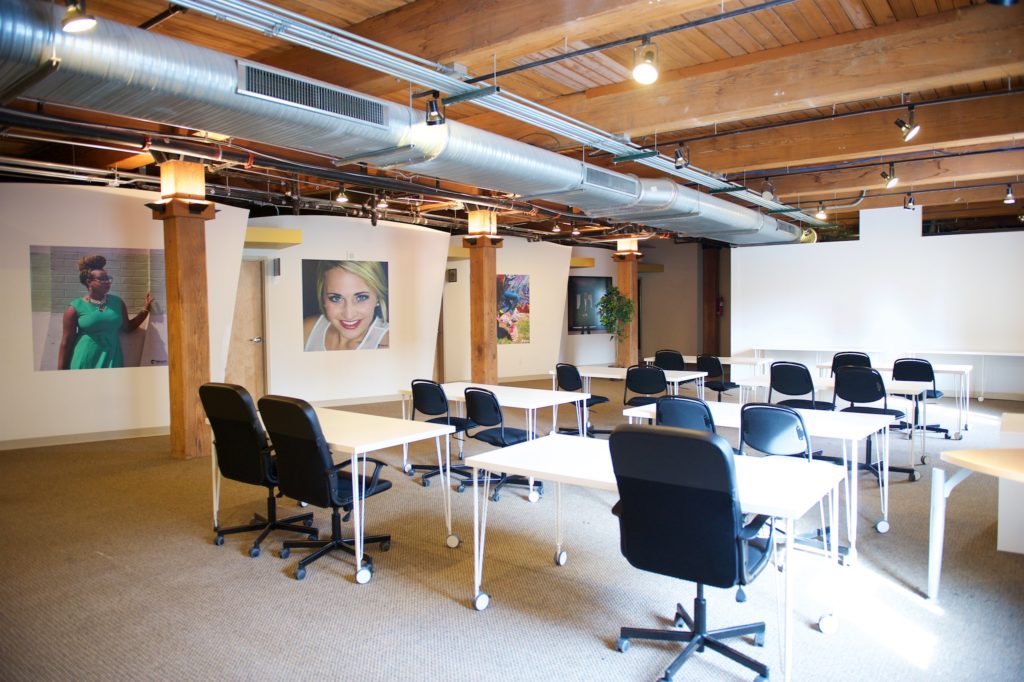
We used to have an office in this building. So, he slept in this building on this floor. We started a clothing line business our first year in college. We actually grew up in this building. My uncle owns this building. When we were kids my dad used to work here. We didn’t know what he did. He was the utility player. He did everything. At that time, there was nothing on Washington. This was the only building that was renovated. There was a club on the first floor that my aunt and uncle owned. It was really popular in the ’90s and early 2000s. The building’s named after my grandfather.
“Why did you decide to call it the Finesse Center?”
His artist name was Rell Finesse. It fit him because it was like you make a way out of no way. He was struggling at Webster. We were living together for a brief time, and we were struggling, but we all made a way. Through grief, we made a way. Through not having money, we made a way. Through him failing out of college, he made a way. The Finesse Center is a place for artists to make a way no matter what you do, no matter what your art is. You will always have a space here to make a way out of no way. There are a lot of young artists in St. Louis that are doing their thing. This space is something my brother would have wanted to create if he was still here because this is what he did in his home. I hope it grows. My big idea is to buy one of those schools that have been abandoned and have the Finesse Center in a school with office spaces, a computer lab, a gym for people to hang out or play basketball, have spaces like this where people can just sit.

“What’s your position here? When you started, how did your life get re-routed by doing this now?”
I’m the founder and CEO, but I don’t feel like I deserve that title. I was a teacher. I taught in St. Louis Public School District for three years. I quit my job the last day of school, like, “I’m going to just figure out what I’m going to do.” My brother passed a couple days later. Then it was like, “Okay, now I got the Finesse Center.” I didn’t have a job all summer. I was just getting this together. Now I work at the Boys and Girls Club as a Site Coordinator because I feel like working with children is what I would do even if I didn’t make money from it.
At Webster University I was the President of our Black Student Union by my senior year. I started a mentoring program at Ashland Elementary School. About 20 of us would go to Ashland every Friday to mentor and tutor. As a senior, I thought, ‘I want to teach.’ I did Teach For America, and just happened to get placed in St. Louis. I told them, ‘I want to go to Ashland. I don’t want to go anywhere else.’ So I started teaching at the school where I started the mentor program.
I was committed to that neighborhood — not just the school but that whole community, because my part-time job during the summer — because teachers don’t get paid during summer vacation — was the Boys and Girls Club at O’Fallon Park at the YMCA down the street. That Boys and Girls Club serviced a lot of kids from that neighborhood because it’s down the street from Ashland. Then I stayed after school when the new year started. I would go there and tutor. I was passionate about changing the lives of children in that neighborhood at that school because I saw they needed it the most. I stayed after my two-year Teach For America commitment because I felt like, ‘This is where I’m going to be.’
Unfortunately, I know a lot of people that know somebody that’s been killed by gunfire. That’s a lot of my friends’ reality. I guess it’s just being Black in St. Louis. I remember being at my brother’s funeral and all my brother’s coworkers came. Most of them are white. My cousin was like, “They don’t even understand that this happens to us all the time. Why isn’t this their reality? We live in the same area, we live in the same city, but this just does not happen to white people.” Even I lived in the County when my dad was killed. My brother was killed in the Central West End. I was just like, “I don’t get it, either.” It’s about opportunities. We’ve got to give people better lives.
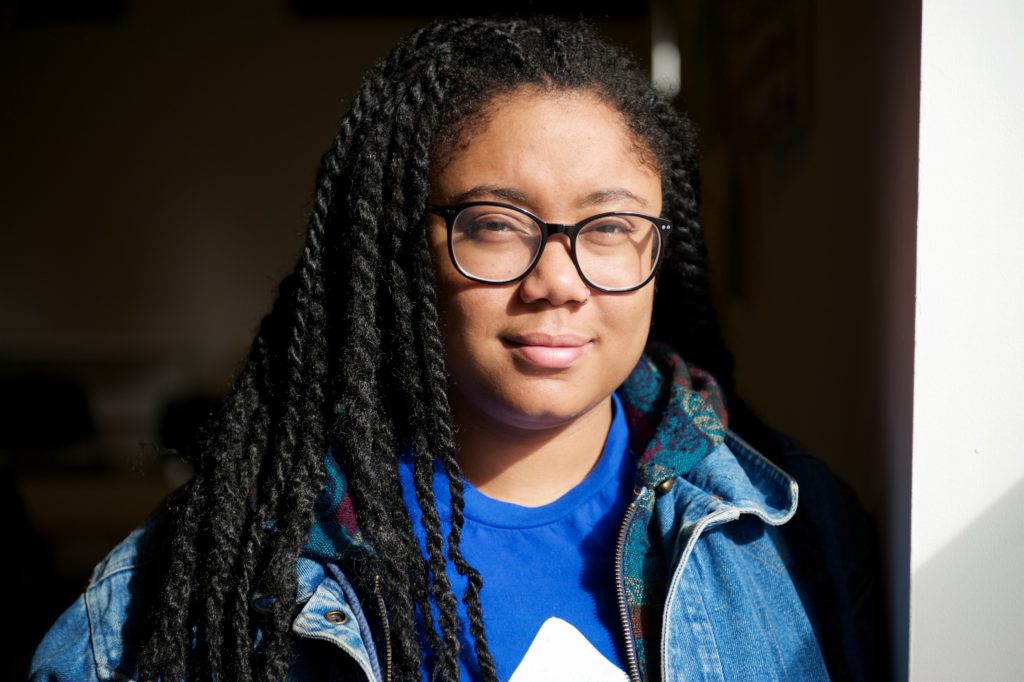
I was always thinking about how the people who took my father’s life were still in high school. They were younger than I was. They went to school with my little brother, who was still in high school at the time. It’s just mind-blowing. ‘You’re a child. How can you make a decision to kill somebody?’ I can understand that kids steal. But killing someone? That’s a whole other level. Throughout college, I was always thinking, ‘How can we change people’s lives?’ You can’t expect people to make better choices if you never give them a better choice. Maybe education is the way you can give people options.
I was a Teach For America teacher my second year teaching, and the first day of school was two days after Mike Brown was killed. The first thing we talked about in my sixth-grade class was about that. I was out protesting at night until two in the morning, then waking up at six in the morning, going to teach, going to protest, and going to teach, for months.
A lot of my lessons were about what was happening in St. Louis. We were in the superintendent zone, so the superintendent squad would come in to observe us. They came in when I was teaching Main Idea using an article about the protests in Ferguson. Last year I talked to kids about Flint, Michigan. I just really wanted them to be socially aware of what was going on.
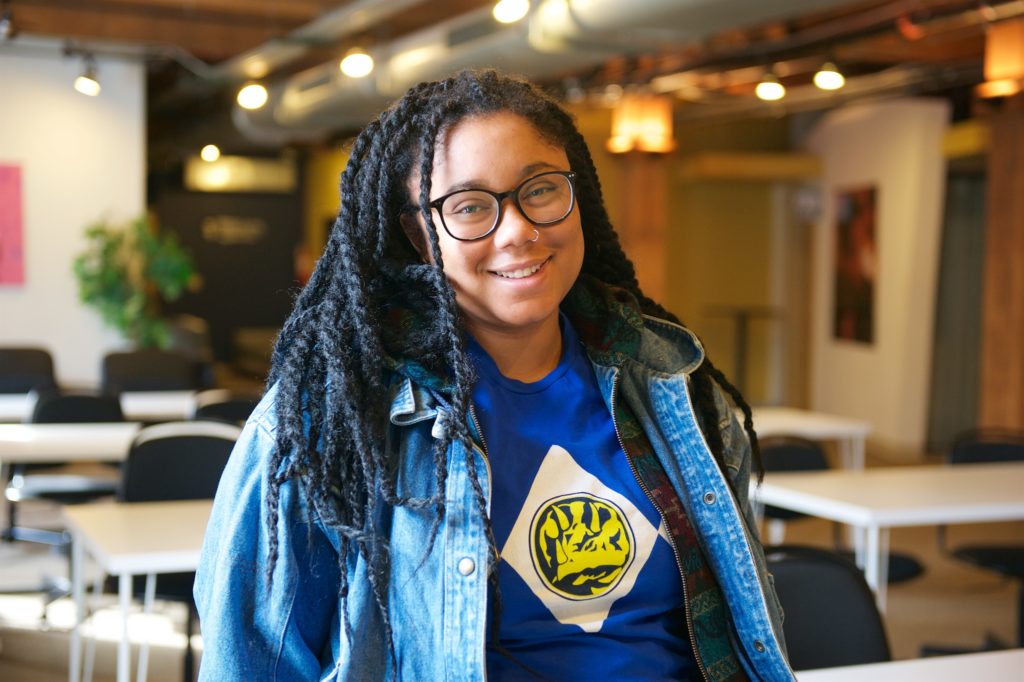
I’ve been doing Camp Justice every year since I started teaching, but last year I really fleshed it out. Every Friday we dedicated the entire day to Camp Justice. The first day we talked to our fourth graders about the definition of poverty. We talked about what it means and what people think it means. We talked about government assistance and homelessness. They were like, “They’re homeless because they’re lazy.” And these are poor Black kids in the city. They were like, “They don’t want to work.” We said, “No, the U.S. government defines poverty as …” We told them, “Here’s the baseline if you receive government assistance, as in food stamps.” I remember seeing the kids’ faces like, wait. Then one girl raised her hand and asked, “Am I poor? Because we got food stamps.” Then we watched this PBS movie called Poor Kids, chronicling the lives of how poverty looks in different families.
The next day we talked about race. I split the kids up into red, blue, green, and yellow groups and told them I would give them a star if they were part of a certain scenario, and based on the stars they would get to go to college for free or something. I would read different scenarios, starting from the 1800s like, “If you are blue, you were owned by other people and you didn’t have rights. You don’t get a star. If you were red, you owned other people and you were able to get an education. You get a star.” The kids didn’t understand until we got to the end when the ones with blue stars asked, “Am I a Black person?” Then the other kids who had all the stars, they were just happy. At the end of the lesson, we talked about it. “How do you feel that you were able to get all of these stars? Do you think it was fair when you didn’t really do anything, it’s just your circumstances.” We had some kids like, “Nah, that’s not fair.” And other kids were like, “I don’t care. It’s not my fault they didn’t get any stars.” I asked them, “So how can we make this fair?” They came to a conclusion together and said, “We can just give them some of our stars.”
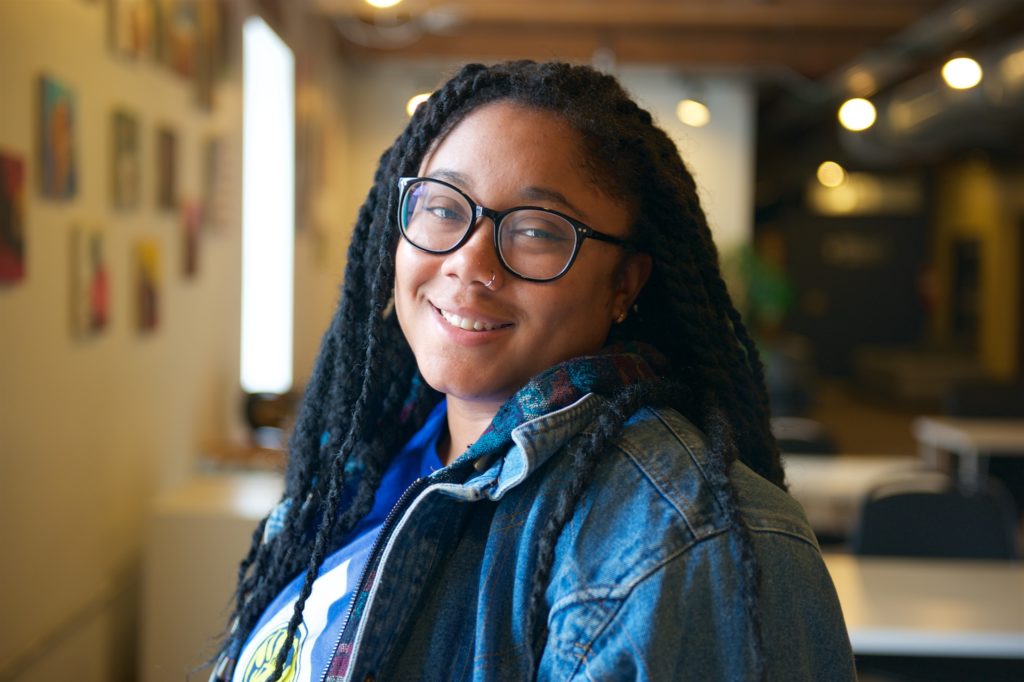
We did another lesson where I put a chair at the front of the room and said, “This chair is a college education. It’s your own business. Or, a nice job. It’s a happy life. All you have to do is sit in it.” The kids just looked at me. Then one kid ran and sat down in the chair. I was like, “Okay, you won.” They were like, “Wait, wait! We weren’t ready.” We did it again and the kid closest to the chair sat down. So we talked about it. “Was this fair? What could we do to make this fair?” “Move the chair to the middle of the room,” they said. “Okay, go.” Still, the closest kid sat in the chair. I was like, “How can we make this fair?” They said, “Let’s put some more in chairs there.” We put some more chairs in there, and then I said, “Go!” Still, not everyone was able to sit.
Then one kid flew and flipped and he still didn’t get into a chair. We asked, “Did you work harder?” I asked one of my kids sitting right next to the chair, “Did you work harder than him? Because we saw him do a flip and try to get this chair and all you did was sit down.” She was like, “No.” I said, “Is that fair that he was running to get to this chair and all you had to do was scoot over?” “No, that wasn’t fair.” We kept talking about it. “How can we make this fair for everyone?” Eventually, they said, “Let’s just get enough chairs for everybody.” We got chairs from the other classrooms. When it was time to go again, we had a kid who was on one side of the classroom and the only empty chair was on the other side and he had to run for a while to sit in the chair. I asked them, “Was this fair?” They said, “Yes because everyone had the opportunity to sit down.”
This is how society works. Some people are born privileged where they’re closer to opportunities so they’re able to sit down without working. Some people are able to sit in a chair although they’re farther away but they had to work extra hard. And then some people who are closer feel like it’s not fair that they were able to sit because they should’ve been able to sit down because they were closer. I taught them that what we’re trying to do is make sure our world is just so everyone has an opportunity to take a seat in a chair. Even if you have to run a little farther, you still have that opportunity at the end of the road. I love the fourth grade. It’s my favorite. I taught fourth, fifth, and sixth grade, and fourth has always been my favorite age group.

